

Community of Christprior to a name change in 2001: Reorganized Church of Jesus Christ of Latter Day SaintsLamoni, Iowa |
||
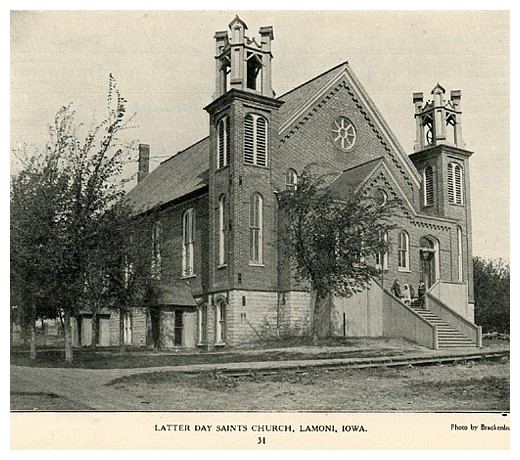 Lamoni RLDS (Old Brick) Church, 1907 Courtesy of Decatur County Historical Museum, Bob Bixby |
||
| LAMONI HAS AN UNUSUAL EARLY
HISTORY FOUNDED AS A CHURCH COLONY |
||
| After Lamoni was platted as a town in 1879, the town experienced a unique history of community pioneering, religious idealism and forward-looking spirit. One group of pioneers were refugees who were traveling westward from Nauvoo, Illinois. They established a camp from 1826 to 1852 at Garden Grove as a stopover in their journey to what would become the State of Utah. Decatur County was organized on April 1, 1850, and shortly afterward the MOREY, KEOWN, MOFFET and HINKLE families moved into the area which is present-day Pleasanton. These families, members of the Reorganized Latter Day Saint Church, embraced the claims of the Reorganization. The congregation at Pleasanton (Little River Branch) were members of the oldest RLDS Church in the county. | ||
| Lamoni's RLDS history begins with the corporation
of the the Order of Enoch. Members of this group were men of means who
were affiliated with the Reorganized Church of Jesus Christ of Latter
Day Saints. The Order of Enoch, organized on September 19, 1870 at
Council Bluffs, Iowa, had the sole purpose of purchasing and developing
lands as church settlements. Among those who were on the Board of Directors, several became prominent in the early history of the RLDS Church in Lamoni. These men were Elijah Banta, president; Israel L. Rogers, treasurer; David Dancer, David Gamet, Alexander McCord, Calvin Beebe, Phineas Caldwell, and H. A. Stebbins, secretary. |
||
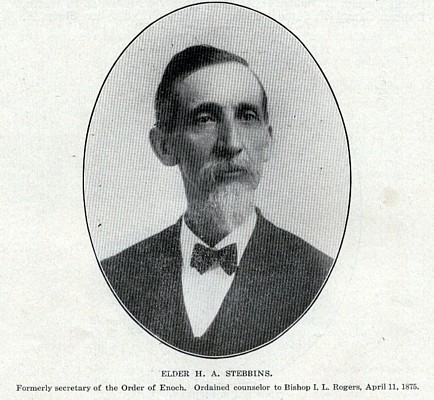 |
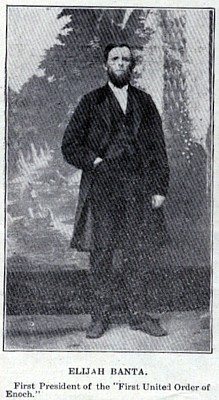 |
 |
| H. A. Stebbins | Elijah Banta | David Dancer |
| A committee, chosen to select a place of settlement,
visited several sites in the states of Missouri, Kansas, Nebraska and
Iowa. They initially purchased 2,686 acres of virgin prairie land in
Fayette Township of Decatur County at a cost of $21,786.41 with a
capital stock of $44,550 which would assure improvement upon the land.
Additional land was purchased later and twelve new houses were built at
a cost of $7,678.40. The Board of the Order of Enoch passed the following resolution in 1874: "Resolved that we proceed to locate a town site upon or near the land belonging to the association as soon as it is found practicable." Originally the settlement was called "The Colony." Choosing the name of a pacifist king from the Book of Mormon, The Order of Enoch called the the new settlement "Lamoni," a name that was approved by the state legislature.  The
first branch of the Latter Day Saints was organized on November 12, 1871
with eighteen members and Charles H. Jones named president. As was usual
for these early pioneer days, first meetings were held in local
schoolhouses. The
first branch of the Latter Day Saints was organized on November 12, 1871
with eighteen members and Charles H. Jones named president. As was usual
for these early pioneer days, first meetings were held in local
schoolhouses.A church was built near the center of the township in 1875. It was a 'rough' structure and never was painted. As Lamoni grew, this first church was abandoned and torn down. The "Brick" Church was erected in 1882 by the Lamoni congregation with an auditorium which could accommodate about 1,000 persons in the main auditorium. The ceiling in the main room was 25-feet tall in the center and the pulpit, a product of fine workmanship, was made of walnut. A church bell hung from the north-side tower on the front of the building. When the RLDS headquarters removed from Plano, Illinois, Lamoni was selected as the new church center. The printing plant was moved to Lamoni in 1881 and the church's first issue of periodicals were published. Soon, Joseph Smith III (1860-1914) and his family relocated to Lamoni, followed by a gradual influx of families. An editorial of the November 15, 1881 issue of The Saints Herald extended an invitation to come to Lamoni . . . "a town of three to four hundred people, away from railroad centers and manufacturing districts . . . . .The idler, the lazy, and the vicious . . . . .will to well to give Lamoni a wide berth; but the industrious, frugal and exemplary we shall welcome to the band of workers." |
||
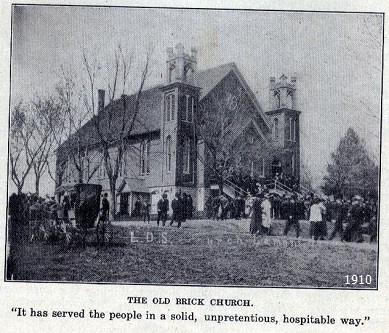  |
||
 Liberty
House, presently known as Liberty Hall, was built in 1881, serving as
Joseph Smith III's home until 1916. Smith was the church president from
1860 to 1914. The home was a center of both social and religious life.
Smith had said at one time, "Liberty Hall throbbed with life, teeming
with the bustling activities of a large and growing family. Birth,
death, and marriage occurred within its walls . . . joys and sorrows
succeeded each other as days the nights." Liberty
House, presently known as Liberty Hall, was built in 1881, serving as
Joseph Smith III's home until 1916. Smith was the church president from
1860 to 1914. The home was a center of both social and religious life.
Smith had said at one time, "Liberty Hall throbbed with life, teeming
with the bustling activities of a large and growing family. Birth,
death, and marriage occurred within its walls . . . joys and sorrows
succeeded each other as days the nights."During the following 60 years, Liberty Hall served as the Saint's Home for the aged, a farmhouse, Civilian Conservation Corps headquarters and a private residence. It was restored to its original 1900-1905 Victorian style. NOTE: Lamoni was frequently the site of the General Conference for the RLDS world church. Joseph Smith III encouraged the development of various church publications, which included: True Latter Day Saint's Herald, the official church magazine established in January of 1860; Zion's Hope, a Sunday School paper established in 1869; and, Autumn Leaves, established in 1888 for young men and women. Marietta Walker was the managing editor of Autumn Leaves. Other publications by The Herald Publishing House and Bookbindery included "Holy Scriptures," a translation and revision of the Old and New Testaments by Joseph Smith, the "Book of Mormon," "The Doctrine and Covenants," "History of Joseph Smith" by E. Tullidge. The office and plant were assessed at a value of nearly $20,000. The Board of Publication consisted of George A. Blakeslee, of Galen, Michigan; Phineas Cadwell, of Logan, Iowa; David Dancer, E. Banta and W. W. Blair, of Lamoni, Iowa. Of these, Mr. Blakeslee was President; Mr. Banta, Treasurer, and Mr. Dancer, Business Manager and in charge. The printing plant at Lamoni consisted of a two-story brick building 30x70 feet in size, containing a counting and sales room, a store-room, mailing-room, press-room, in which an excellent Ames engine of eight horsepower furnished the power, all on the first floor; up stairs, an editorial-room and library containing several hundred volumes belonging to the church; the church recorder's room, later occupied by Elder Henry A. Stebbins, Elder Sheen's successor; a composing-room, where a corps of printers under John Scott, superintendent, set the type. |
||

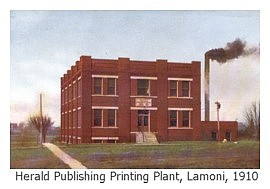 |
||
| Herald Publishing House and Bookbindery suffered a
fire on Saturday morning of January 5, 1907. The entire building,
printing presses and bookbinding machinery, general church offices and
general records and a large stock of books were totally destroyed.
However, general record books kept by the church recorder were saved,
housed in vaults. "Citizens of Lamoni and the vicinity took Vigorous
action to assist in rebuilding the plant" (right). The building was
later utilized by Graceland University and later by Lamoni Elementary
School until it was torn down ca. 2009. Lamoni was incorporated in December, 1885. The first ordinance passed by the Town Council prohibited the existence of beer saloons and gambling tables. The second ordinance that passed prohibited horses, cattle and hogs from running at large. |
||

 |
||
| NOTE: In 1941 the Saint's Home was converted into a
boy's dormitory at Graceland College and elderly Saints residing at
Saint's Home were moved to Liberty Hall. ~ Lamoni Chronicle,
Jan. 01, 1942 The Saint's Home (1907) for aged people, a charitable institutions, comprised of 175 acres of farm land. |
||
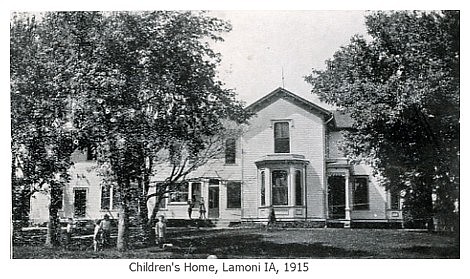 |
||
 Graceland
College was founded in 1895 with land donated by church members. The
first 20 acres was donated by Marietta Walker (Walker Hall was named in
her honor). Graceland's first day of classes was September 17, 1895.
While the administration building was under construction, classes were
held in a building downtown. There were 18 male and female students
enrolled with four faculty members and a dean. Graceland
College was founded in 1895 with land donated by church members. The
first 20 acres was donated by Marietta Walker (Walker Hall was named in
her honor). Graceland's first day of classes was September 17, 1895.
While the administration building was under construction, classes were
held in a building downtown. There were 18 male and female students
enrolled with four faculty members and a dean.The name "Graceland" was selected by Col. George Barrett who selected and surveyed the site. The name aptly described the graceful slope of the hill upon which the college was built. Although the college is maintained by the RLDS Church, it is a non-sectarian institution. When the administration building, the first building on the campus, was dedicated on January 1, 1897, RLDS Church president Joseph Smith III declared that the college "should be free to all irrrespective of faith or creed." The college tract originally comprised of 66 acres of land. Enrollment in 1905-06 was 145 students from 16 states and territories. A nursing program was launched in 1910 in cooperation with the Independence [MO] Sanitarium and Hospital. The college received accreditation in 1917, becoming the first fully accredited junior college in Iowa. Graceland became a four-year college in 1960, and Graceland University on June 1, 2000. In 2011, 2012 and 2013, Graceland University has been ranked in the 'first tier' in the U.S. News & World reports of America's best colleges. The Princeton Review has recognized Graceland University as a top school in the Midwest. In 1920, the RLDS Church moved its headquarters to Independence, Missouri. The "Brick" Church burned on January 29, 1931. (Clements, Ella Neal. "A History of the Boy Scouts of Lamoni, Iowa." Lamoni RLDS Church Historian. 27 Mar 1973.) |
||
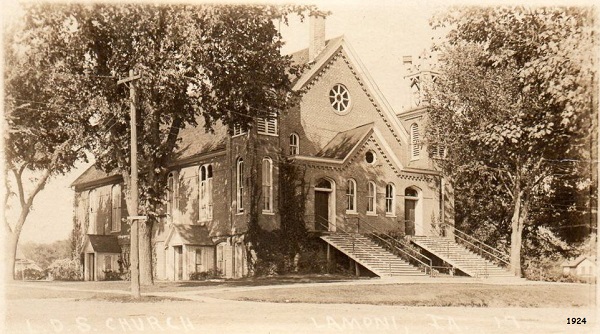 |
||
| Then.... and now | ||
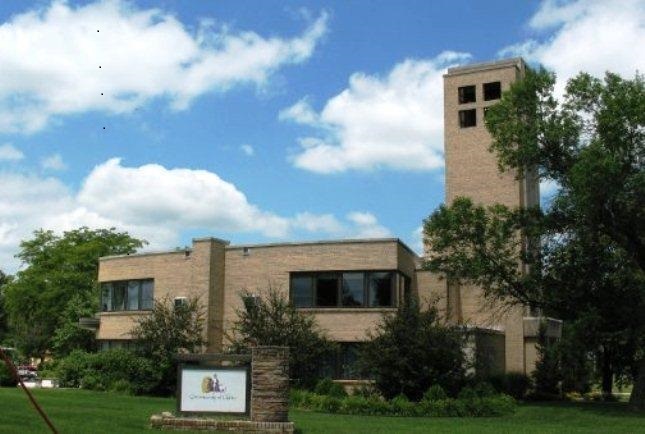
 |
||
| SOURCES: "Biographical and Historical Record of Ringgold and of Decatur Counties, Iowa." Pp. 782-90. Lewis Pub. Co. Chicago. 1887. Semi-Centennial History of Lamoni; Lamoni Bank Souvenier of 1907; graceland.edu/About-GU/History/index Compilation and submission by Sharon R. Becker, July of 2013; updated July of 2015; updated December of 2015 |
||
| Church Index * Decatur County IAGenWeb | ||